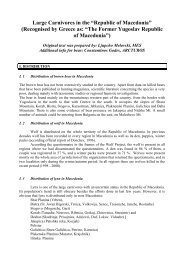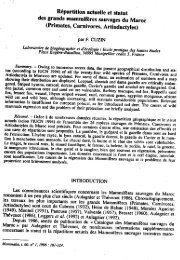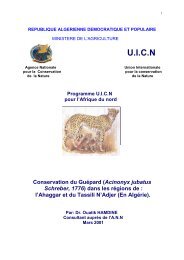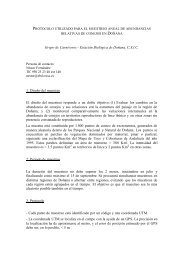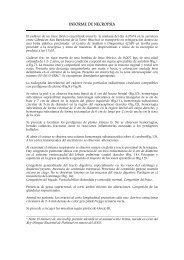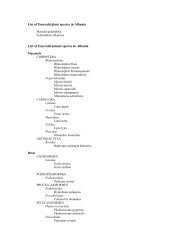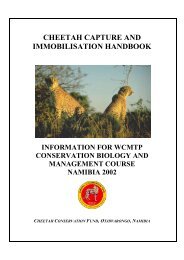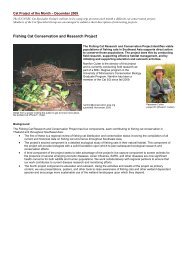Research-based Sumatran Tiger Conservation in a Multi-use ...
Research-based Sumatran Tiger Conservation in a Multi-use ...
Research-based Sumatran Tiger Conservation in a Multi-use ...
Create successful ePaper yourself
Turn your PDF publications into a flip-book with our unique Google optimized e-Paper software.
Staff capacity build<strong>in</strong>g <strong>in</strong> field research<br />
data management (Photo Sunarto).<br />
My project foc<strong>use</strong>s on:<br />
1. Identify<strong>in</strong>g areas still hold<strong>in</strong>g tigers, estimate the density <strong>in</strong><br />
major habitats, and predict the probability of occurrence<br />
across the landscape.<br />
2. Dissem<strong>in</strong>at<strong>in</strong>g research f<strong>in</strong>d<strong>in</strong>gs for habitat protection,<br />
management and restoration, <strong>in</strong>clud<strong>in</strong>g the development of<br />
new protected areas and improved management of tiger<br />
habitats.<br />
3. Build<strong>in</strong>g local capacity on tiger conservation.<br />
Methods<br />
To reveal the ecological characteristics of tigers <strong>in</strong> the landscape we <strong>use</strong>d a variety of field techniques which <strong>in</strong>clude <strong>in</strong>terviews and<br />
ad-hoc surveys to document tiger presence, camera trapp<strong>in</strong>g for abundance estimation, and detection-non detection/occupancy<br />
estimation to predict the occurrence of tigers.<br />
Identify<strong>in</strong>g areas still hold<strong>in</strong>g tigers<br />
Identification of tiger presence <strong>in</strong> the landscape <strong>in</strong>volved stages of activities. First, potential habitats for tigers are identified, ma<strong>in</strong>ly<br />
<strong>based</strong> on the land cover. We considered the rema<strong>in</strong><strong>in</strong>g forest as the potential habitat. Areas of large forest patches are the target<br />
area where tiger presence is to be confirmed. We <strong>use</strong>d different approaches <strong>in</strong> gather<strong>in</strong>g <strong>in</strong>formation on tiger presence which<br />
<strong>in</strong>clude <strong>in</strong>terview<strong>in</strong>g authorities and local people, direct survey for tiger sign, as well as camera trapp<strong>in</strong>g and other systematic<br />
sampl<strong>in</strong>gs such as occupancy survey.<br />
Map of The Tesso Nilo-Bukit Tigapuluh <strong>Conservation</strong> Landscape <strong>in</strong> Southern Riau Prov<strong>in</strong>ce,<br />
Sumatra.<br />
Estimat<strong>in</strong>g the abundance of tigers us<strong>in</strong>g<br />
camera traps<br />
We found that <strong>in</strong> our study area camera traps<br />
are only effective for <strong>use</strong> <strong>in</strong> forested areas.<br />
This was due to high human activities and<br />
low probability to capture wildlife <strong>in</strong> areas<br />
outside of forests. We placed 13 equallyspaced<br />
possible camera trap sampl<strong>in</strong>g<br />
blocks, each measur<strong>in</strong>g ca. 128 km 2 <strong>in</strong> the<br />
ca. 17,000 km 2 forests <strong>in</strong> the Tesso Nilo-Bukit<br />
Tigapuluh <strong>Conservation</strong> Landscape (see<br />
map).<br />
To beg<strong>in</strong> with, we selected 4 sampl<strong>in</strong>g<br />
blocks, represent<strong>in</strong>g 3 major habitat types <strong>in</strong><br />
the landscape, to be covered <strong>in</strong> the first two<br />
year. We covered each sampl<strong>in</strong>g blocks with<br />
+/- 40 camera traps placed <strong>in</strong> pairs <strong>in</strong> about<br />
20 sites. Photographic data generated from<br />
camera trapp<strong>in</strong>g were ma<strong>in</strong>ly <strong>use</strong>d to<br />
estimate the density of naturally marked<br />
animals such as the tiger, us<strong>in</strong>g capturemark-recapture<br />
techniques. For animals<br />
which have no natural mark<strong>in</strong>g <strong>in</strong>dividually,<br />
we estimate the relative abundance <strong>based</strong> on<br />
the photographic capture rates.<br />
To estimate the relative abundance of tigers<br />
and their prey outside of forest habitat, we<br />
<strong>use</strong>d another technique such as the<br />
detection-non detection or occupancy survey





